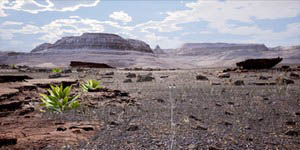Instant Terra v1.2 is now available!
Organize your graphs by grouping nodes, drive node parameters through masks or formula, play with the new rock erosion simulation, and more!
Improvements on erosion simulation
Hydraulic erosion has been improved: This node includes new presets including Light, Balanced, Strata weathering, Diffuse weathering, Favor carving, Only carving, and Only fluid simulation.
 You can now compute and export the hydraulic erosion simulation flow map as a mask.
You can now compute and export the hydraulic erosion simulation flow map as a mask.

We are thrilled to deliver a beta version of rock erosion simulation and although we have not yet finished optimizing it, it is already very useful and provides effective results:

New Calculation nodes
Instant Terra v1.2 groups a new category of calculation nodes that compute operations on numbers.
Formula node: The Formula node allows you to create a formula that can be applied to several nodes at the same time.

Parameter node: The Parameter node defines the minimum and maximum values of the output value, and the number of decimal places for these values.

Constant node: The Constant node is a simplified Parameter node. It has one output node that is defined by a value entered in the parameters.

Four nodes, Plus, Minus, Multiply, and Divide, provide mathematical operations on numbers and have no parameters.

Drive node parameters with masks or calculations
Optional connectors link to a formula or a mask node and replace the input value in the linked node. Blue connectors link to calculation nodes (Formula, Constant, etc.) and bi-color connectors link to either a calculation node or a mask.

When using masks, you can drive one parameter of the output terrain to give a variable result over the terrain.

Group nodes
In the Graph editor, you can group nodes to move them together and differentiate parts of a project. You can also create sub-groups of nodes within groups.
Compute and export the normal map
Compute and export the normal map of an input terrain to be able to add surface detail such as bumps, grooves, and scratches to a model that catch the light as if they are represented by real geometry.

Multiply masks
This new node multiplies two input masks. At each vertex, the value of the output mask is the multiplication of the values of both input masks.

Minimum and maximum mask values
This new mask transformation node sets the minimum and maximum values of a mask.

Other new features
Tiled export (depending on your version): When working with large terrains or masks, automatically spilt your export files into several small files using the terrain and mask Multi file export node.

Automatic backup: Instant Terra automatically backs up the current project in the same directory, once the project has been saved.

Edit menu: The Graph contextual menu entries are now also found in the Edit menu.

Import and export to relative directories: When you have saved your project, you can import or export files in the same folder as the project, or in a sub-directory.
New tutorial and workflows
Getting started tutorial: The Getting started tutorial helps you to become familiar with the Instant Terra interface and to create your first terrain.
Painted mask workflow: The Painted mask workflows helps you get started with painting masks in the 3D Viewport.
Compute and export normal maps: In this workflow, learn how to compute and export the normal map of an input terrain and export it to be able to add surface detail such as bumps, grooves, and scratches to a model.


